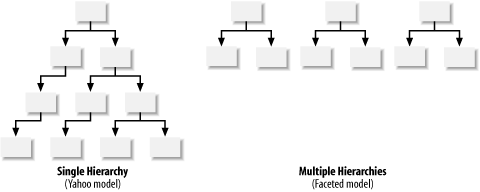Faceted Classification
In the 1930s, an Indian librarian by the name of S. R. Ranganathan created a new type of classification system. Recognizing the problems and limitations of these top-down single-taxonomy solutions, Ranganathan built his system upon the notion that documents and objects have multiple dimensions, or facets.
The old model asks the question, “Where do I put this?” It’s more closely tied to our experience in the physical world, with the idea of one place for each item. In contrast, the faceted approach asks the question, “How can I describe this?”
Like many librarians, Ranganathan was an idealist. He argued that you must build multiple “pure” taxonomies, using one principle of division at a time. He suggested five universal facets to be used for organizing everything:
Personality
Matter
Energy
Space
Time
In our experience, the faceted approach has great value, but we don’t tend to use Ranganathan’s universal facets. Instead, common facets in the business world include:
Topic
Product
Document Type
Audience
Geography
Price
Still confused about facets? See Figure 9-27. All we’re really doing is applying the structure of a fielded database to the more heterogeneous mix of documents and applications in a web site. Rather than the one-taxonomy-fits-all approach of Yahoo!, we’re embracing the concept of multiple taxonomies that focus on different dimensions of the content.

Get Information Architecture for the World Wide Web, Second Edition now with the O’Reilly learning platform.
O’Reilly members experience books, live events, courses curated by job role, and more from O’Reilly and nearly 200 top publishers.

